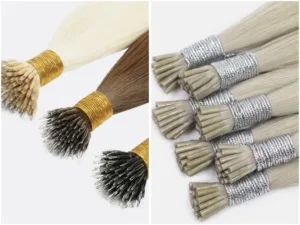Do you know the weft hair extensions? I guess you must have heard of them! Yes, weft hair extensions are a foundational product in the hair extension industry, 70%-80% of hair extensionists use this method! And as techniques improve, new variations of weft hair extensions are created! Let’s take a closer look at different weft hair extensions and why they are so important.
Weft hair extensions refer to gathering the tops of the hair strands together through sewing, tying, or taping to form a hair weft, available in different types such as hand-tied weft hair, machine weft hair, tape in weft hair, flat weft hair, and more. They offer flexibility in application, allowing stylists to use sewing, beads, or tape methods depending on the client’s hair type and preferences.

Curious about how these different types of weft hair extensions can benefit your business? Let’s explore why they are essential and the advantages they offer to both wholesalers and stylists.
Types of Weft Hair Extensions
As a professional, it’s vital to understand the different types of weft hair extensions so you can recommend the best product for your clients. Beyond hand-tied and machine-tied wefts, there are several other variations that can suit a wide range of client needs.
Machine Wefts / Volume Wefts
Machine Wefts and Volume Wefts are both woven by machine, thicker and more durable, making them perfect for clients with medium to thick hair. They can hold more hair, provide more volume, and are a sturdy option for clients seeking long-lasting extensions.

Hand-Tied Wefts
Hand-tied wefts are known for being thin and lightweight, making them ideal for clients with fine hair. They are meticulously tied by hand, allowing them to lay flat against the scalp, giving a natural, undetectable appearance. These wefts are often favored in luxury salons due to their seamless blend with natural hair.

Genius Weft
Genius wefts combine the benefits of both hand-tied and machine-tied wefts. They are thin and lightweight, like hand-tied wefts, but provide the sturdiness of machine-tied wefts. This makes them a popular choice for clients who want a balance between durability and a natural appearance.

Tape In Weft
Tape In wefts are designed to blend with natural hair by using taped wefts .These are great for clients seeking a more discreet look and fast installation time.

Flat Weft
Flat wefts are crafted by wrapping the top of the hair strands with premium silk, creating a smooth and durable finish. This design ensures a flat, comfortable fit against the scalp, offering a sleek, natural look.

Butterfly Weft
Butterfly wefts are innovative injection tech crafted with a Pu weft featuring evenly spaced holes along the top. This unique design allows for easier needle insertion during installation, making the process faster and more efficient, while maintaining a discreet and seamless appearance.

sub2.
Weft Hair Extensions Install & Weft Hair Extensions Pros and Cons
When it comes to installing weft hair extensions, the right method depends on the client’s hair type, the desired look, and how long they plan to wear the extensions. For weft extensions, there are three primary installation methods: sewing, beads, and tape. Each offers a different level of permanence and flexibility.
Sew-in Method
Sewing weft hair extensions is one of the most common and reliable methods. This technique involves braiding the client’s natural hair into cornrows and then sewing the wefts onto these braids. It’s a long-lasting solution, making it popular with clients looking for semi-permanent extensions that can stay in place for weeks or even months with proper care.
Who it’s best for: Clients with thick, strong hair that can support the tension of cornrows.
Pros: Secure, long-lasting, and no adhesives or chemicals are required.
Cons: Not suitable for clients with fine or weak hair, as the braids can put too much strain on the scalp.

Beads Installation
The beads method involves attaching weft extensions to the client’s natural hair using small metal or silicone-lined beads. Sections of the natural hair are pulled through the bead along with the weft, and the bead is then clamped to secure everything in place. This method doesn’t require any heat, glue, or braiding, making it gentler on the hair.
Who it’s best for: Clients with medium to thick hair who want flexibility with their extensions.
Pros: Easy to adjust or remove, less tension on the scalp compared to sew-ins, and no adhesives are used.
Cons: Beads can sometimes slip or cause discomfort if not installed correctly. Regular maintenance is required to adjust the beads as the natural hair grows.

Tape-in Weft Installation
Tape-in wefts are pre-taped hair extensions that are sandwiched between sections of the client’s natural hair. Th e tape method is known for being fast to install and lightweight, making it ideal for clients who want a semi-permanent option without the commitment of sew-in extensions.
Who it’s best for: Clients with fine to medium hair who prefer a natural, seamless look.
Pros: Quick to install, lays flat against the scalp, and can be reused with new tape. It’s also less damaging for fine hair compared to other methods.
Cons: Requires maintenance every 6-8 weeks as the hair grows, and oil-based products can weaken the adhesive.
By offering these different installation methods, you can cater to a wide range of client preferences and hair types, ensuring that each client gets the best possible result based on their specific needs.
How to Choose the Right Weft Hair Extensions for Your Client
Choosing the right weft hair extensions involves understanding your client’s preferences, hair type, and the look they want to achieve. Here’s a simple guide to help you make the best recommendation:
Consider the Client’s Preferences
Many clients who regularly wear hair extensions already have a preferred type of extension, or they may want to try something new. It’s important to listen to what they like or are curious about, whether it’s a specific installation method like tape weft or a particular type like hand-tied or flat wefts. If the customer has requirements for installation speed, they may consider Tape in hair weft and Butterfly weft.

Consider the Client’s Hair Type
Fine or Thin Hair: Clients with fine hair usually do well with hand-tied or genius wefts. These types are lightweight and blend naturally with their hair, reducing strain on the scalp.
Medium Hair: For clients with medium hair, flat wefts, tape in weft, or even machine wefts work well. They provide volume and are versatile enough for different styles.
Thick Hair: Machine or genius wefts are ideal for clients with thicker hair. These wefts can hold more hair, adding volume and length without compromising durability.

Consider the Desired Look
Seamless and Natural: If the client wants their extensions to be completely invisible, handtied wefts or genius wefts are great choices. They blend seamlessly into the natural hair for a discreet, undetectable finish.

Durability and Volume: For clients who need long-lasting extensions with more volume, machine wefts or volume wefts are ideal. These wefts provide added thickness and are designed for durability over time.
Lightweight and Comfort: Clients who prioritize comfort and want lightweight extensions should consider Butterfly or Genius wefts. These wefts are designed to be light, reducing tension on the scalp, and are comfortable for long-term wear.
Neat and Sleek Appearance: For clients who want their extensions to lie flat and create a clean, sleek look, flat wefts and butterfly wefts are the best options. These wefts provide a smooth, natural look without adding bulk, making the overall hairstyle look polished and tidy.
By considering these factors, you can confidently recommend the best weft hair extensions that match your client’s hair type, preferences, and styling goals.

CONCLUSION
Weft hair extensions are a key product for both wholesalers and stylists, offering durability, flexibility, and a range of styles to fit different client needs. Whether your client wants a seamless blend, added volume, or a lightweight option, there’s a weft extension to suit their preferences. By understanding the various types and installation methods, you can confidently recommend the right weft hair extensions for any client, enhancing both their experience and your service offerings.
Hibiscus Hair Manufacturer has been focusing on the production of weft hair extensions for 25 years and are an industry leader in this field. If you are interested, please check for our more details.
HAIR WEFT




